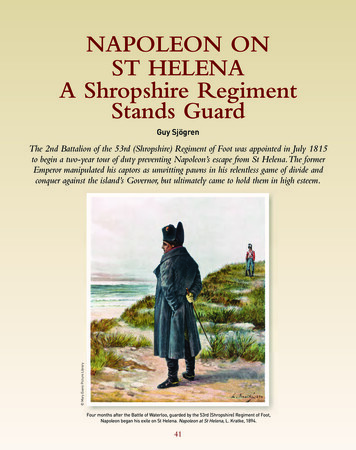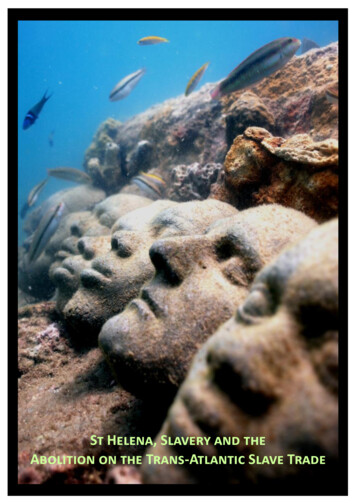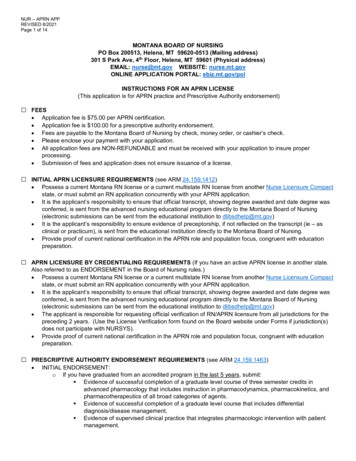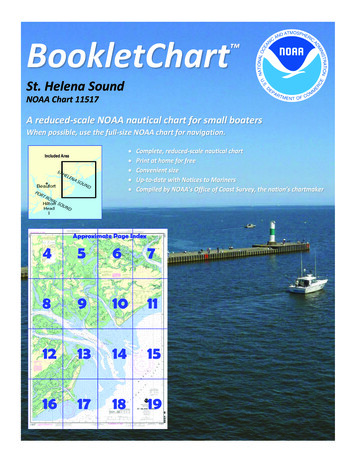
Transcription
NAPOLEON ONST HELENAA Shropshire RegimentStands GuardGuy Sjögren Mary Evans Picture LibraryThe 2nd Battalion of the 53rd (Shropshire) Regiment of Foot was appointed in July 1815to begin a two-year tour of duty preventing Napoleon’s escape from St Helena.The formerEmperor manipulated his captors as unwitting pawns in his relentless game of divide andconquer against the island’s Governor, but ultimately came to hold them in high esteem.Four months after the Battle of Waterloo, guarded by the 53rd (Shropshire) Regiment of Foot,Napoleon began his exile on St Helena. Napoleon at St Helena, L. Kratke, 1894.41
Anne S.K. Brown Military Collection, Brown University Library.NAPOLEON ON ST HELENAOn that ‘vast mass of rock rising abruptly from the Atlantic Ocean’ Napoleon occupied Longwood, the Governor’s summer residence.View and Plan of Longwood House, St. Helena, the residence of Napoleon Bonaparte, 1817. Rudolph Ackermann (publisher).‘How far is St Helena from the field of Waterloo?’A near way – a clear way – the ship will take you soonA pleasant place for gentlemen with little left to do.(Morning never tries you till the afternoon!)from Rudyard Kipling, A St Helena LullabyAs dawn broke on the morning of 28 July 1815 aKing’s Messenger clattered into Portsmouth.Secure in the galloper’s saddlebag was an orderfrom the Commander-in-Chief addressed to Colonel SirGeorge Bingham, the commanding officer of the 2ndBattalion 53rd (Shropshire) Regiment of Foot, thenstationed in the naval town. The order directed the 53rdto prepare for ‘immediate embarkation for distantservice’. At 11 o’clock the battalion formed up forinspection, ‘when every man appeared under arms and incomplete marching order’.In view of the dramatic events of the previous fortnight,there seemed little doubt that the ‘distant service’ was to beon the South Atlantic island of St Helena. And so it was that,some ten weeks later, the battalion disembarked from twotroopships lying off Jamestown and were ferried ashore.Thus began a two-year tour of duty, the sole objective ofwhich was to ensure that Napoleon remained secure in hisremote island prison. It also marked the beginning of anunusual and fraught triangular relationship betweencaptive, gaolers and ‘higher authority’ in the form of theBritish government and the island’s Governor.42
The ‘Old Five andThreepennies’The 53rd Foot had beenraised as a singlebattalion in 1755.However, at the turn ofthe nineteenth century,the imperial and wartimeinvolvement of theBritish Armynecessitated itsexpansion, as a result ofwhich a second battalionof the 53rd was formedin 1803. The FirstBattalion deployed toIndia two years later,leaving the Second tofight its way throughSpain during thePeninsular War. Bythe summer of 1815,the 2nd-53rd was backin England. Anne S.K. Brown Military Collection, Brown University Library.NAPOLEON ON ST HELENASir Hudson Lowe, Governor of St Helena and his prisoner taunt eachother. Hudson Lowe: Oui général, c’est un bien petit royaume pour ungrand homme comme vous! Napoleon: Heureusement, c’est tout lecontraire pour vous, Sir Lowe! (Hudson Lowe: Yes, General, it's quite asmall kingdom for a great man like you! Napoleon: I'm happy to say thatit's quite the opposite for you, Sir Lowe!)Three days of feverishactivity followed the arrivalof the King’s Messenger inPortsmouth, and on 1August the battalion beganto embark on thetroopships Bucephalus andCeylon anchored offSpithead. The troopshipsarrived in Tor Bay on 6August where, by now, theBellerophon was waiting.Napoleon was thentransferred to HMSNorthumberland and, earlythat evening, theNorthumberland, thetroopships and escorts,under the command ofAdmiral Sir GeorgeCockburn, weighed anchorand headed out into theEnglish Channel.Exile to St HelenaThere is little doubt thatNapoleon’s departure fromEurope was met with relief in many quarters. TheMorning Post of 3 August argued that, while he had lostphysical power, he still possessed a moral power, andthat ‘to give him his liberty would enable him to disturbthe repose of the world’. Four days later, the samenewspaper was in even less conciliatory mood, referringto Napoleon as ‘this wretch’ and an ‘inhuman tyrant’. Itwould take some ten weeks and a ‘boisterous passage’for the squadron to reach St Helena and deliver its‘obnoxious charge’ (the Morning Post again) ashore.The ShropshireRegiment’s archives holda document whichstates: ‘The result of the Battle of Waterloo, havingdeprived Bonaparte of all powers, induced him to adoptthe determination of delivering himself to the Britishgovernment.’ This is not quite true. Napoleon’s originalaim was to escape to the United States, one option beingto smuggle him out of Rochefort hidden in a barrel aboarda Danish vessel carrying a cargo of brandy. However, theRoyal Navy’s blockade of the port made this impossibleand, on 15 July, Napoleon boarded HMS Bellerophon,declaring to the captain: ‘Sir, I am come to throw myselfupon the protection of your Prince and of your laws.’While permanent accommodation was being prepared forNapoleon at Longwood – hitherto the Governor'ssummer residence – Napoleon spent his first two monthson the island living in a small pavilion adjacent to ‘TheBriars’, the home of William Balcombe of the HonourableEast India Company. There, and with Cockburn asGovernor, he seems to have been reasonably content. Allwas to change, however, with his removal to Longwood inDecember 1815 and the arrival of General Sir HudsonLowe as Governor the following April.Protection he was certainly given, but not in the way thathe wanted. Stripped of his imperial title, Napoleon washenceforth referred to as ‘General Bonaparte’; and,rather than living a quiet life in England as he had hoped,he was dispatched to what the naval surgeon assignedto him described as ‘a vast mass of rock rising abruptlyfrom the Atlantic Ocean jagged and irregular, cut andslashed, as it were, cut into pieces by the great hatchetof nature’.43
Anne S.K. Brown Military Collection, Brown University Library.NAPOLEON ON ST HELENANapoleon caricatured employing his military skills with the legions of rats to be found on St Helena. War in the East against the Cats,by Napoleon the Great, of St. Helena. Thomas Rowlandson and Rudolph Ackermann, February 23, 1816.Lowe has received a bad press. He has been described asunimaginative, unbending and over-zealous in histreatment of the former Emperor; even Wellingtonthought him the wrong man for the job. And yet Lowe borethe almost overwhelming responsibility of applying thegovernment’s regulations, the sole objective of which wasto prevent Napoleon from escaping, as he had done fromElba the previous year. But if Lowe considered Napoleon aprisoner, the former Emperor did not. Even when aboardthe Bellerophon, Napoleon had remonstrated: ‘Tell thePrince Regent that I have one thing to ask, my liberty oran executioner. I am not the prisoner of England.’ Protestas he might, he was clearly treated as such.A naval exclusion zone was thrown around the island,whilst on land Napoleon’s movements were constrained.Longwood sat on a plateau 1,800 feet above sea level andhis movements were restricted to an area aroundLongwood some twelve miles in circumference.The ‘Shropshire lads’ of the 2nd-53rd were camped a mileaway at Deadwood Plain. Soldiers patrolled the plateau,manned temporary outposts, or picquets, placed atintervals around the perimeter, and acted as sentries inthe immediate vicinity of Longwood. Living at Longwoodwas Captain Thomas Poppleton, the senior captain of the53rd assigned as Napoleon’s orderly officer.Napoleon sympathised with the lot of the 53rd, occupiedas they were with largely passive duties. ‘I have no reasonto complain about them’, he said, ‘they treat me withrespect, and even appear to feel for me.’ When not onguard duty, the soldiers were constantly formed intofatigue parties.Everything required at Longwood and Deadwood had to belaboriously manhandled up from the town – even water,as there was none on the plateau. In Napoleon’s opinion,it would have been better to have dedicated resources ‘in44
NAPOLEON ON ST HELENAconducting water to those poor soldiers in camp thanthrow up fortifications round the house, just as if an armywere coming to attack it’.Divide and conquerIn view of the tight military security surroundingNapoleon, it was clearly impractical for him to considerescaping from St Helena. On the other hand, like anyprisoner of war, he refused to accept his situation, and tothis end he employed all his well-honed political andstrategic skills: skills he had used to keep the loyalty ofhis army and the support of the people. If he could notmake a physical escape from the island, he would find analternative way of gaining his liberty. His strategy broughthim deliberately into constant conflict with the Governor.It also involved him in playing a game of divide andconquer; a game in which he would use elements of the53rd as unwitting pawns.Napoleon recognised that his only hope of getting off theisland was to generate sympathy from his supporters inFrance, as well as sympathetic liberals in England. Herealised that if he submitted to Lowe and the regulations,he would be forgotten by the public – out of sight, out ofmind. Thus through intermediaries, smuggledcorrespondence and meetings with travelling visitors, hewould complain about his treatment: a lack of decentfood, insufficient wine, inadequate supplies of hay for thehorses, the living conditions at Longwood, and the rats.‘The rats are in numbers almost incredible at Longwood’,wrote Barry O’Meara, Napoleon’s doctor. The 53rd’s campat Deadwood was equally infested and, in his memoirs,O’Meara describes a rat hunt led by Captain Poppleton.One of the restrictions that particularly irked Napoleonwas the need to be accompanied by Poppleton wheneverhe went riding. ‘Not that I have any objection toPoppleton’, he said, ‘I love a good soldier of any nation.’On one occasion, Napoleon suddenly turned his horse andgalloped up a steep slope. Unable to follow him,Poppleton hurried off to the Governor. ‘Sir, I have lost theEmperor!’ he reported, only to be told to go back toLongwood where he found Napoleon at lunch.Whilst the former Emperor may have had fun atPoppleton’s expense, he also appears to have regardedthe officer with some affection. Nevertheless, he alsoused him for his own purposes. Lowe was furious onlearning that Napoleon had borrowed a case or two ofclaret from Poppleton, and that the latterhad ‘often lent candles, as well as bread,butter, poultry and even salt’. Equally, itwould not have pleased Lowe to know thatNapoleon held his ‘red regiment’, as hereferred to the 53rd, in high esteem. ‘Theyare a regiment of brave men and havefought valiantly.’ Lowe would also not havecared for Napoleon’s ‘high approbation’ tohave been referred to by Lord Bathurst,Secretary of State for War and the Colonies,in the House of Lords.‘Adieu, mon ami’When, in July 1817, the time came for the53rd to be relieved as guard regiment,Napoleon asked that the officers beallowed to wait upon him. The regimentalarchives note that: ‘After wishing themevery happiness and prosperity, he thankedthem for the attention and respect he hadalways experienced.’ He then presentedPoppleton with a gold snuff box, saying:‘Adieu, mon ami, voilà la seule bagatelleque me reste’ (Farewell, my friend; this isthe one trinket I have left). Lowe was not sogenerous and, suspecting that Poppletonwas carrying home secret papers fromNapoleon, set a charge against him.Bathurst, however, rejected it. This was tobe the final twist in the brief triangularrelationship between Lowe, Napoleon andthe ‘Old Five and Threepennies’.Guy Sjögren is a doctoral research student at theCentre for West Midlands History, the University ofBirmingham.Further reading:Lucia Elizabeth Abell, Napoleon and Betsy:Recollections of Napoleon on St Helena, edited by AlanSutton (Fonthill, 2012).Paul F. Brunyee, Napoleon’s Britons and the St HelenaDecision (The History Press, 2009).Brian Unwin, Terrible Exile: The Last Days of Napoleonon St Helena (Tauris, 2010).La Fondation Napoléon at www.napoleon.org.Further information on the 53rd (Shropshire) Regimentof Foot can be accessed online viawww.shropshireregimentalmuseum.co.uk.45
NAPOLEON ON ST HELENA 45 Guy Sjögren is a doctoral research student at the Centre for West Midlands History, the University of Birmingham. Further reading: Lucia Elizabeth Abell, Napoleon and Betsy: Recollections of Napoleon on St Helena, edited by Alan Sutton (Fonthill, 2012). Paul F. Brunyee, Napoleon's Britons and the St Helena










